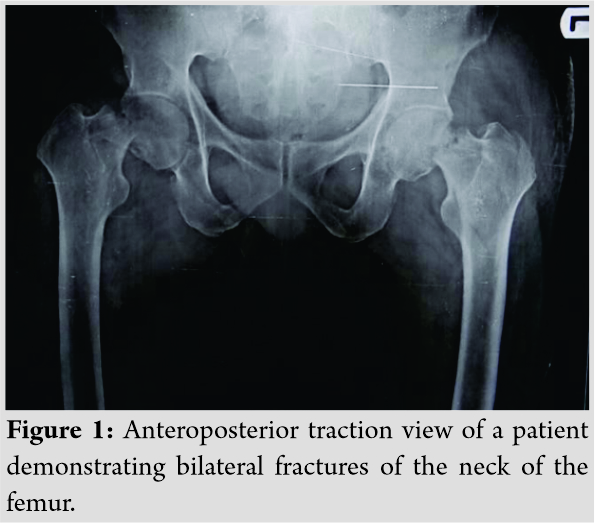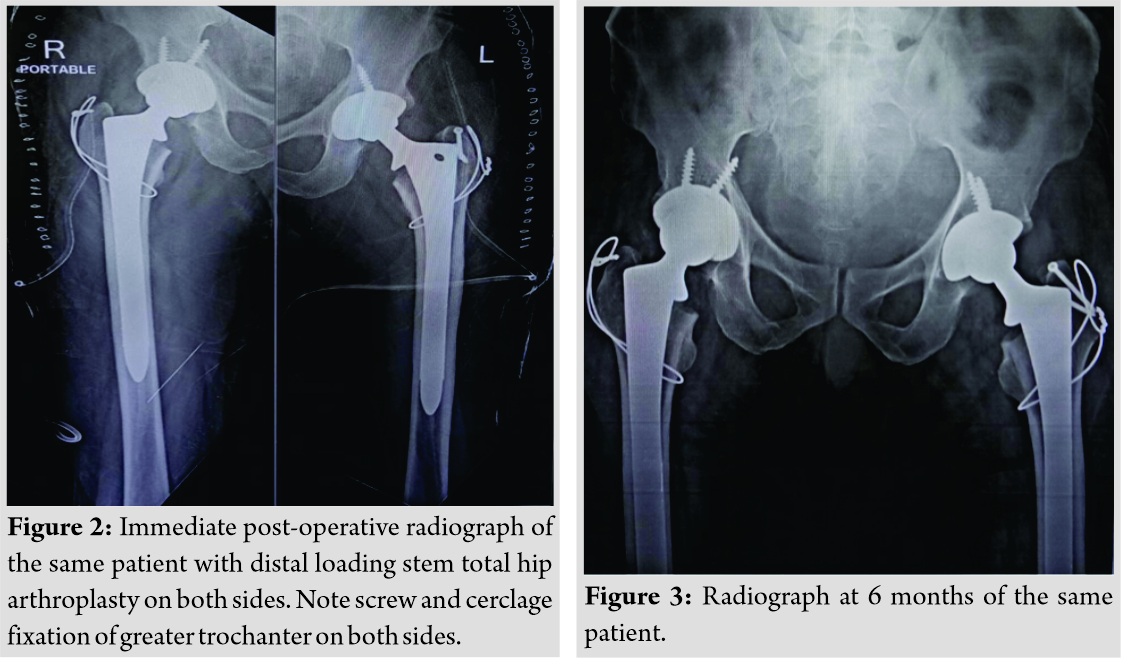[box type=”bio”] Learning Point of the Article: [/box]
Excellent results can be obtained with arthroplasty in case of bilateral neck femur fractures.
Case Report | Volume 10 | Issue 5 | JOCR August 2020 | Page 9-11 | Hemant Mathur, Shivam Shah. DOI: 10.13107/jocr.2020.v10.i05.1814
Authors: Hemant Mathur[1], Shivam Shah[2]
[1]Department of Orthopaedics, Sir Sayajirao General Hospital and Medical College Baroda, Vadodara, Gujarat, India.
Address of Correspondence:
Dr. Shivam Shah,
Department of Orthopaedics, Sir Sayajirao General Hospital and Medical College Baroda, Vadodara, Gujarat, India.
E-mail: shivam.shah92@gmail.com
Abstract
Introduction: Introduction: Bilateral intracapsular neck of femur fractures is rare and has been reported in patients with metabolic bone diseases, after electroconvulsive therapy and due to stress fractures. Total hip arthroplasty (THA) is considered as a treatment of choice for old aged patients. Surgery done in a single sitting for such patients helps in early mobilization.
Case Report: A 60-year-old male, known case of epilepsy and chronic renal disease, presented to us with bilateral intracapsular fracture of neck of femur following episode of convulsion. The patient was operated for a distal loading stem THA on both sides in a single sitting. Proximally deficient hip was managed with screw and cerclage looping fixation of greater trochanter on both sides. The post-operative course was uneventful. At 2 weeks, the patient was allowed protected weight-bearing with a walker. At 8 weeks, the patient was doing full weight-bearing, while at 4 months, the patient was carrying out all activities of daily living. Mean Harris hip score was 86 at the end of 6 months.
Conclusion: Bilateral long stem distal loading THA can give good clinical and functional outcomes in a case of the bilateral neck of femur fracture with a deficit of proximal femur. The patient can safely be operated for arthroplasty on both sides in a single sitting. Single sitting surgery will help in early mobilization and better functional outcomes.
Key words: Bilateral fractures of the neck of femur, Distal loading stem, Total hip arthroplasty.
Introduction
Hip fractures are a common occurrence throughout the world, with the United States alone seeing over 340,000 hip fractures per year [1]. With the increasing age, incidences of hip fractures are also rising. Reasons being a reduction in bone density and an increase in the frequency of falls. Between ages 60 and 85 years, the risk of hip fracture doubles for every 5- to 6-year increases in age [2]. The majority of hip fractures occur unilaterally. Bilateral injuries are infrequent. Bilateral hip fractures have been reported in patients with metabolic bone diseases, after electroconvulsive therapy, and due to stress fractures [3]. Management of fracture neck of the femur is surgical. Depending on the age of the patient, osteosynthesis with compression screws for the younger age group and hemi or total hip replacement arthroplasty (total hip arthroplasty [THA]) for the older age group is advocated [2, 3]. THA with a distal loading stem is considered for patients with the proximally deficient femur [3, 4]. We present a case of bilateral fractures of the neck of the femur, treated with bilateral distal loading long stem THA, which was carried out in a single stage. To the best of our knowledge, such a case has not been reported.
Case Report
A 60-year-old male, known case of epilepsy and chronic renal disease, presented to us with complaints of pain over the bilateral hip and inability to walk 5 days after the history of convulsion. On examination, the patient revealed the bilateral hip joint tenderness with an inability to perform straight leg raising. Anteroposterior traction view of both the hips with pelvis was taken, which revealed a bilateral fracture of the neck of the femur (Fig. 1).
Preoperative physician’s fitness was obtained, and the patient was posted for surgery. Since the patient had a fracture following trivial trauma with poor bone quality, arthroplasty was chosen over osteosynthesis. Furthermore, the goal of early mobilization was aimed for such a comorbid patient. For the operative intervention, both cemented as well as uncemented prosthesis, proximal and distal loading stems, and wire loop system were kept ready. The patient was positioned into a lateral decubitus position with the left side up. The left side was first operated with Moore’s approach. A proximally deficient femur was noticed with a comminuted fracture of a greater tuberosity. THA was performed with uncemented distally loading long stem and uncemented acetabular cup replacement (Solution stem, Depuy J and J). Wire looping of the greater trochanter was added. The patient was turned, and the right side was operated. With similar intraoperative findings, the same procedure was carried out on the right side also. On both sides, screw fixation of greater tuberosity was added over and above wire loops. The post-operative X-ray showed the precise positioning of an implant (Fig. 2).
Deep vein thrombosis prevention prophylaxis was administered. The patient was allowed in bed hip and knee range of motion exercises on the same day of surgery. The post-operative course was uneventful. The sutures were removed at 2 weeks. The patient was allowed protected weight-bearing after suture removal with the use of a walker and was discharged at 2 weeks. There were no wound complications. Protected weight-bearing using walker was continued up to 6 weeks, followed by a tripod stick. Stair climbing was allowed after 12 weeks. The patient was followed up every 2 months for 6 months. At the end of 4 months, the patient was carrying out all activities of daily living. Serial x-rays of the hip were done to look for the migration of the implant or the presence of translucent areas around the acetabular implant. No signs of aseptic loosening or subsidence of femoral stem are seen (Fig. 3). The mean Harris hip score was 86 at the end of 6 months.
Discussion
Bilateral fractures of the neck of the femur are rare. Since 1970, only 20 cases of bilateral femur neck fractures after convulsive seizures have been reported in the literature [5]. Violent contraction of the periarticular, pelvic-trochanteric muscles during the seizure, is the principal cause of these fractures. Cases of concomitant, associated fractures, proximal humerus, and acetabulum are mentioned in the literature. Blomfeldt et al. [6], in a large randomized control trial, compared the results of primary internal fixation and THA following neck of femur fracture in the elderly. The authors noted that primary total hip arthroplasty provides a better outcome for mentally competent elderly patients with a displaced femoral neck fracture. The rates of complications and reoperation were significantly lower. Hip function and health-related quality of life were at least as good at 4 years after the surgery [6]. Ben and Gordon, in their study comparing the results of THA and bipolar Hemi replacement arthroplasty in the neck of femur fractures [4], concluded that THA gave a vastly superior functional outcome compared to a hemiarthroplasty. The rates of revision arthroplasty were higher in the hemiarthroplasty group. However, higher rates of dislocations were found in the group with THA. Stephen and Rodriguez [7], in their study about proximally coated distal loading stem in the presence of proximal femoral deficiency, suggested that “the presence of a deficient or mechanically compromised proximal femur represents a particular challenge to THA.” The authors also concluded that distal fixation in the presence of a deficient or mechanically compromised femur is a reliable solution to these challenging problems. Maurya and Thukral [8], in their study of 15 patients with proximally deficient femur treated with distal loading stem, concluded that the extensively coated cementless (“Solution™”) femoral stem provides a reasonable “solution” to the deficient femur in hip revision. Authors also concluded that the proximal femoral deficiencies could be easily bypassed, and distal fixation can be achieved with the use of this stem. Following the same principles supported by literature, in our patient considering the goal of early mobilization and stability, THA was considered. Furthermore, the proximal femoral deficit was managed with distal fixation using long stem and wire looping. Going through the literature, we could not find a specific mention of single-stage surgery for bilateral fractures. Such an execution takes a little longer time, but given a proper medical condition of a patient, a single anesthesia procedure serves as a boon to the patient. We could swiftly mobilize the patient early and obtain excellent patient satisfaction. With this being the strength, we do need more number of similar cases.
Conclusion
Bilateral long stem THA, carried out in a single sitting, can yield good clinical and functional outcomes in a case of the bilateral neck of femur fracture with a deficit of proximal femur. However, large randomized control trials are required before the universal adoption of this technique.
Clinical Message
Although the bilateral neck of femur fracture cases are rare, an attempt to perform single sitting surgery of distal loading stem, THA can safely be undertaken. Such an surgery will be a boon for the patient.
References
1. Brauer CA, Coca-Perraillon M, Cutler DM, Rosen A. Incidence and mortality of hip fractures in the United States. JAMA 2009;302:1573-9.
2. Kim SH, Meehan JP, Blumenfeld T, Szabo RM. Hip fractures in the United States: 2008 nationwide emergency department sample. Arthritis Care Res (Hoboken) 2008;64:751-57.
3. Paruk F, Matthews G, Cassim B. Osteoporotic hip fractures in black South Africans: A regional study. Arch Osteoporos 2017;12:107-12.
4. Ben S, Gordon B. Displaced intracapsular neck of femur fractures in mobile independent patients: Total hip replacement or hemiarthroplasty. Injury 2007;30:345-8.
5. Hughes CA, O’Brian DS. Sudden death from pelvic hemorrhage after bilateral central fracture dislocations of the hip due to an epileptic seizure. Am J Forensic Med Pathol 2000;12:380-4.
6. Blomfeldt R, Törnkvist H, Ponzer S, Söderqvist A, Tidermark J. Comparison of internal fixation with total hip replacement for displaced femoral neck fractures. Randomized, controlled trial performed at four years. J Bone Joint Surg Am 2011;93:445-50.
7. Stephen BM, Rodriguez J. Revision total hip arthroplasty with proximal bone loss. J Arthroplasty 2004;19:115-9.
8. Maurya SK, Thukra S. Extensively coated revision stems in proximally deficient femur: Early results in 15 patients. Indian J Orthop 2008;42:287-93.
 |
 |
| Dr. Hemant Mathur | Dr. Shivam Shah |
| How to Cite This Article: Mathur H, Shah S. A Rare Case of Bilateral Fracture Neck Femur Treated with Bilateral Distal Loading Stem Total Hip Arthroplasty, in a Single Sitting. Journal of Orthopaedic Case Reports 2020 August;10(5): 9-11 |
[Full Text HTML] [Full Text PDF] [XML]
[rate_this_page]
Dear Reader, We are very excited about New Features in JOCR. Please do let us know what you think by Clicking on the Sliding “Feedback Form” button on the <<< left of the page or sending a mail to us at editor.jocr@gmail.com






